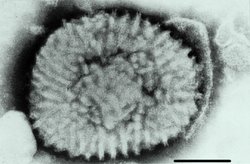In 1849, 18 years before the Meiji Revolution, cowpox vaccination was first successful in Nagasaki, which was the only city open to foreign visitors during the Tokunaga Era. This method became widespread throughout Japan. Dr. Ryusai Kuwata (Bunka 8/1811-Keio 4/1868) from Edo (modern Tokyo) made this color woodcut print to advertise the effectiveness of the vaccination to protect against smallpox; he used this picture at the Osaka Vaccination Clinic. The white cow in the print represents vaccination.
It was known that among persons and families who tended cows, the clinical signs of smallpox were never serious. Following this clue, Dr. Kuwata tried vaccinating children with the contents of eruptions from cowpox. As a result, the children's illness was mild and not transmitted to others. Dr. Kuwata, who was the pioneer of vaccination in Japan, vaccinated more than 70,000 people. He died with a vaccination needle in his hand in 1868, when he was 58 years old.
COPYRIGHT 2000 U.S. National Center for Infectious Diseases
COPYRIGHT 2001 Gale Group



